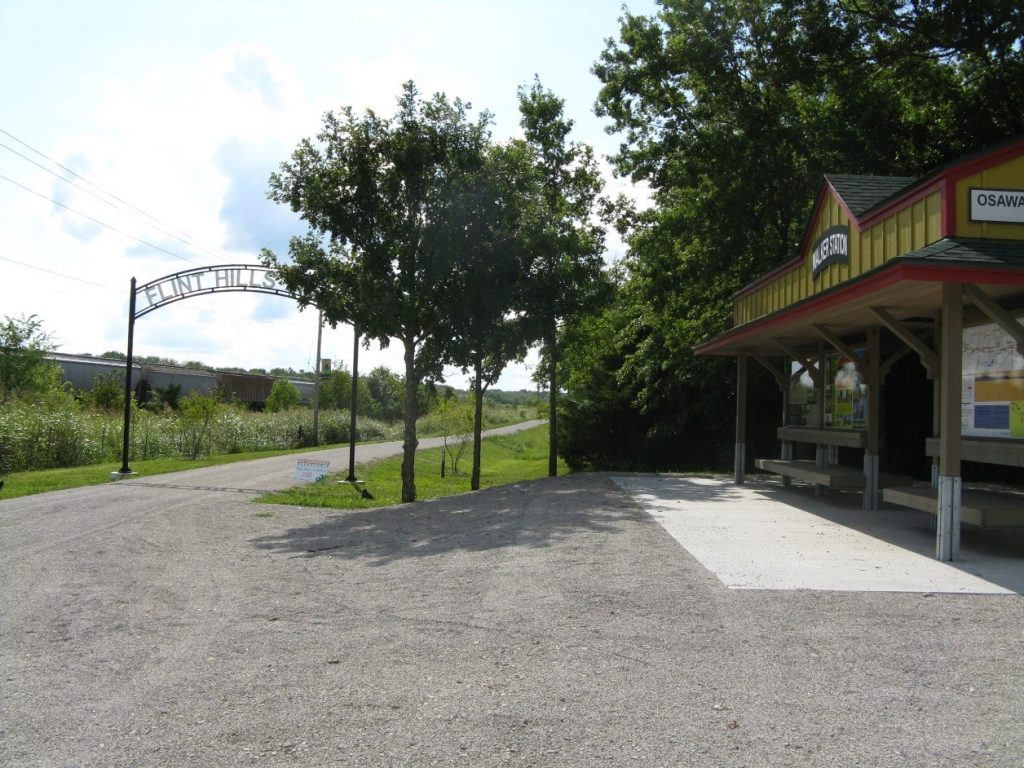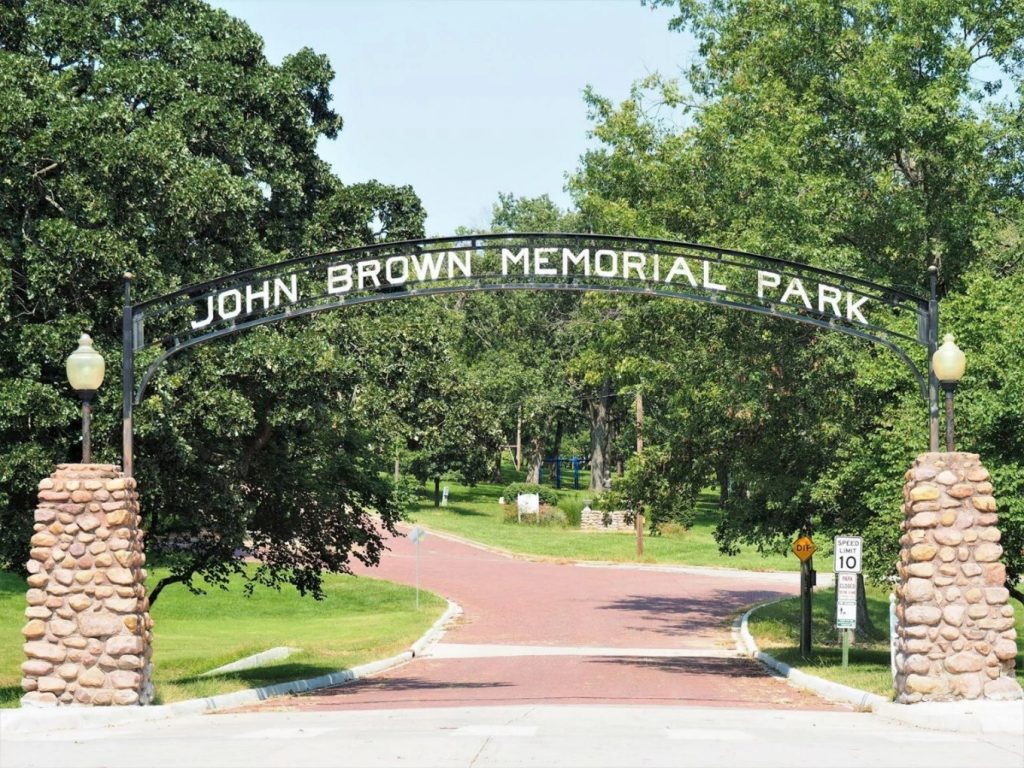Mills House

William M. Mills, an oilman from Pennsylvania, drilled over 400 oil and gas wells in his lifetime. He drilled the Norman #1 well in Neodesha, Kansas which was the first successful commercial oil well west of the Mississippi and opened up the mid-continent oil field. His companies supplied gas to the towns of Osawatomie, Paola, and Spring Hill.
In 1902, he used profits from these ventures to build a magnificent home on First St. in Osawatomie. The Queen Anne style house was designed by the famous architect, George Barber, and cost $49,000 to build. It has:
- 7,000 square feet
- 9 fireplaces
- elaborate woodwork
- ornamental ceilings
During the mid-1900s, the house was converted into several apartments and was allowed to deteriorate. Fortunately, the home is now being restored to its original beauty by former State Senator Doug Walker and his family. The home is listed on the National Register of Historic Places.
Asylum Bridge

This is one of the most unusual and unique bridges in the country. Located just ½ block north of the Mils House RV Park.
At quick glance it looks like a very small cantilever truss bridge. However, closer inspection on the arrangement of the truss members suggests it functions in another manner. Most sources consulted seem to have agreed that this bridge lacks cantilever function. Without engineering study, two possibilities remain. Each span may function as a simple truss, with the “towers” and adjacent top chord sections being largely decorative. In this case, the unusual truss shape of the center span has been described as a “Reserve Parker.” Another possibility is that the bridge may function as a continuous (but not cantilever) truss. If so, it would be an early use of continuous truss design, and as such it might not be a totally perfect representation of continuous truss design, as this was more or less a period where continuous truss design was somewhat experimental.
Despite its unique design, the bridge sits abandoned and overgrown. This bridge deserves no less then the highest preservation priority.
Flint Hills Trail

Owned and originally developed by volunteers of the Kanza Rails to Trails Conservancy Inc., the Flint Hills Trail is now Kansas’ newest State Park. The 119 mile trail is one of the longest in the United States. The trail begins in Osawatomie and currently ends 96 miles west in Council Grove. Work continues to develop the trail the remaining 20 miles on to Herington. To access the Mile Zero trailhead, travel west on Main Street to 12th, then turn left, (south) for 4 blocks and follow the signs.
John Brown Memorial Park

John Brown, considered a fanatical abolitionist by some and a martyr by others, is closely associated with the proslavery and free-state struggle of the Kansas Territorial period (1854-1861). John Brown followed five of his sons to Kansas in 1855 where he saw an opportunity to help make Kansas a free state — bringing a wagon load of weapons along with him. He made headquarters at the log cabin belonging to his half-sister Florella Adair and her husband, the Reverend Samuel Adair.
In May of 1856, a small party consisting mainly of Brown and his sons raided the cabins of proslavery men, killing five of them. Up to that time there had been little bloodshed between proslavery and free-state groups. Brown’s raid brought retaliation. On August 30, 1856, Brown and his followers were attacked by a large force of border ruffians. In the “Battle of Osawatomie” five of Brown’s men, including one of his sons, were killed and the town of Osawatomie was burned.
Brown was in and out of the area over the next few months and took part in the border skirmishes near Ft. Scott. Later, on December 23, he made a raid into Missouri to liberate slaves and other property from slaveholders. The group was hidden in the Adair Cabin and later safely made their way to Canada and freedom.
The John Brown State Historic Site is located in beautiful John Brown Memorial Park, which was dedicated by President Teddy Roosevelt in 1910. The family-oriented park sits on the site of the Battle of Osawatomie and houses the John Brown Museum, which includes the original Adair family cabin. Through artifacts and interpretation, visitors learn about the struggles of these early pioneers.
Adair Cabin

The Adair cabin, originally located just outside of town to the west, was carefully dismantled and relocated to John Brown Park. It is encased in a protective stone pavilion to help preserve it for generations to come.
It took hard work and courage to take a firm stand against the spread of slavery into Kansas Territory. Kansas was admitted as a free state in 1861.
MoPac Railroad Depot Museum

Located next door to the Osawatomie History Museum, the MoPac Railroad Depot Museum is an exact replica of the town’s original train depot. Dedicated in 2002, the depot museum houses the majority of the Osawatomie History Museum’s railroad artifacts and memorabilia.
The Kansas Republican Party was organized in Osawatomie in 1859 and Horace Greeley, founder and editor of the New York Tribune, attended the first convention on his famous overland journey to promote a transcontinental railroad.
The railroad, then the St. Louis-Kansas-Arizona line, reached Osawatomie in 1879, and later became the Missouri Pacific and now the Union Pacific and was for years the principal employer in Osawatomie. The Union Pacific still operates a major switching operation in Osawatomie.
Old Stone Church

Located at 315 6th Street, the church was built by Rev. Samuel L. Adair and his son Charles, of native stone hauled from the hills around the city. It was dedicated on July 14, 1861. Rev. Adair was many things to the community, a kind hearted abolitionist, a minister, and a mental health pioneer. The brother-in-law of John Brown, Rev. Adair first served as a volunteer chaplain and then the first official chaplain at the Osawatomie State Hospital.
Renovation was started on the church on October 7, 1948 and rededicated July 14, 1963 as an All Faith Chapel. The building can now be rented for special meetings and weddings. If you are interested in using the Church for your special event, please contact our Utilities Department at 913-755-2146, Option 1.







